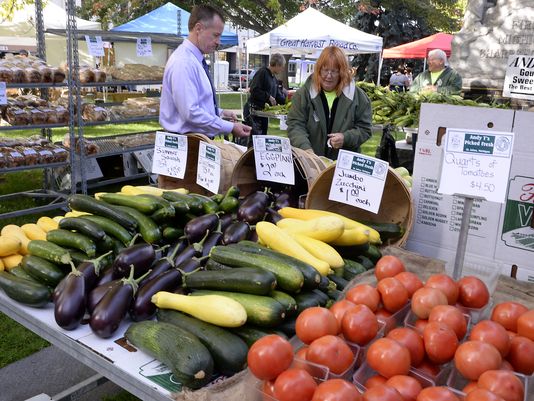Fresh Food Access
April 24, 2015
Source: Lansing State Journal
Author: Senator Debbie Stabenow and Oran Hesterman
Making things and growing things are Michigan specialties. From industry to apples, we have a history of taking something good and making it even better.
And when our state comes up with an idea that can help the rest of the country, we want to share it.

Fresh produce is on sale the Farmers market at the state Capitol last fall. The writers discuss expansion of programs that help low income families increase their spending on fresh produce. (Photo: Rod Sanford/LSJ)
Double Up Food Bucks is a project that was pioneered by Michigan’s small farmers who wanted to ensure low-income families could get access to fresh fruits and vegetables. That program is now going national, and it will soon be helping millions of other farmers and families across the country.
The idea is simple: When families spend their food assistance dollars at participating farmers markets or grocery stores, the value doubles — that is, they get a dollar-for-dollar match to spend on locally grown fruits and vegetables.
It’s a winning combination: low-income families take home more healthy food; local farmers get more customers and make more money; and local economies keep more of those food dollars in the community.
In fact, Double Up Food Bucks has been so successful in Michigan that it inspired bipartisan support for the funding of similar programs in the recent Farm Bill, signed into law last year by President Obama at Michigan State University.
Earlier this month, the U.S. Department of Agriculture awarded Michigan’s Fair Food Network $5.1 million to continue innovating Double Up Food Bucks. Additional funds will launch Double Up projects in other states that are learning from our work in Michigan.
Fair Food Network started its project six years ago in five Detroit farmers markets.
Double Up attracted funders like the W.K. Kellogg Foundation and a range of partners — from government agencies to statewide networks and other nonprofits. Along the way, Fair Food and its partners grew the number of communities served by Double Up to more than 150 and introduced new innovations. They tested it to see if it was doing what it was supposed to do.
And it was. More than 90 percent of food assistance users report eating more produce with Double Up, and more than half said they bought fewer high-fat snacks. A majority of shoppers also say the prices, quality, and selection of fresh produce at farmers markets was better than where they usually shopped. Farmers also benefitted with 85 percent reporting making more money with Double Up.
But the work is far from over. With the USDA funding—along with $5 million more in matching funds raised from private sources — partners across Michigan will start innovating again.
Fair Food Network will use part of the funding to expand Double Up Food Bucks in grocery stores, where families shop most often. Michigan has led the nation in bringing incentives to the grocery arena, and Fair Food Network will use this funding to reach 50 groceries by 2018.
That’s a powerful way to reach more families in need, and support the food economy in our backyard.
Fair Food Network will also expand its Kent County mobile payment pilot to more farmers markets across the state, so instead of using tokens, farmers can use their smartphones to process payments. And it will begin offering Double Up in some farmers markets and grocery stores year-round, rather than only during the summer and harvest seasons.
We have successfully created a model that brings people together: farmers and families, cities and small towns, Democrats and Republicans, and public and private investors.
We have demonstrated how this program can tackle critical issues simultaneously: improving healthy food access, fostering better health, and stimulating economic opportunity and job creation. And we’ve shown what hard work and collaboration, backed with strong philanthropic support plus far-sighted leadership, can achieve together.
It’s a proven program. And now with this federal investment, the people of Michigan are going to continue the work to make it even better.
First posted at Lansing State Journal on April 18, 2015.







